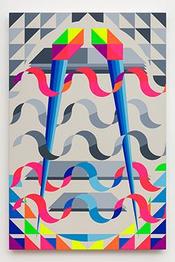Art Movements
Op Art
Op Art (also known as Optical Art) is a form of non-objective, non-representational, abstract art. It is very precise and exact, highly thought out and meticulously executed, there is no element of chance. Op Art is often rooted in mathematics, using geometric forms as building blocks, including lines and frequently based on a grid organization. The movement was most active during the early 1960s to the early 1970s.
The Op Art geometric shapes and compositions are characterized by sharp contrasts and precision, which can be in black and white or in high contrast, high key colors. The strong contrasts in color, geometry and composition excite and activate the eye, making the mind more receptive to illusory images, thus challenging visual perception and making the mind think it is seeing something different. What is often observed includes vibrating shapes, undulating movements, bending of elements and compositions, three-dimensional space and extremes in perspective and depth perception. Due to the activation and excitation of the eye, Op Art is frequently referred to retinal art.
Visual perception refers to the brain's ability to make sense of what the eyes see.It is the minds ability to interpret the surrounding environment using light in the visible spectrum reflected by the objects in the environment.
Illusory refers to imagery that causes illusions that can fool, deceive or mislead the mind into perceiving something different that what the eye is actually seeing.
Op Art is frequently associated with Concrete Art, Kinetic Art and the Constructivist Movement.
Some of the earliest artists associated early with the Op Art movement included Victor Vasarely (1908-97), Bridget Riley (b.1931), Julian Stanczak (1928-2017), Richard Anuszkiewicz (b 1930) and Edna Andrade (1917-2008). The exhibition, “The Responsive Eye”, organized by William C. Seitz and presented at the Museum of Modern Art, New York, New York, February 23 through April 25, 1965, is largely credited with popularizing the Op Art Movement.

 Ernst Benkert
Ernst Benkert
 Thomas Downing
Thomas Downing
 Gabriele Evertz
Gabriele Evertz
 Christian Haub
Christian Haub
 Andrew Huffman
Andrew Huffman
 Matthew Kluber
Matthew Kluber
 Mokha Laget
Mokha Laget
 Heather McGill
Heather McGill
 Dee Shapiro
Dee Shapiro
 Oli Sihvonen
Oli Sihvonen






























